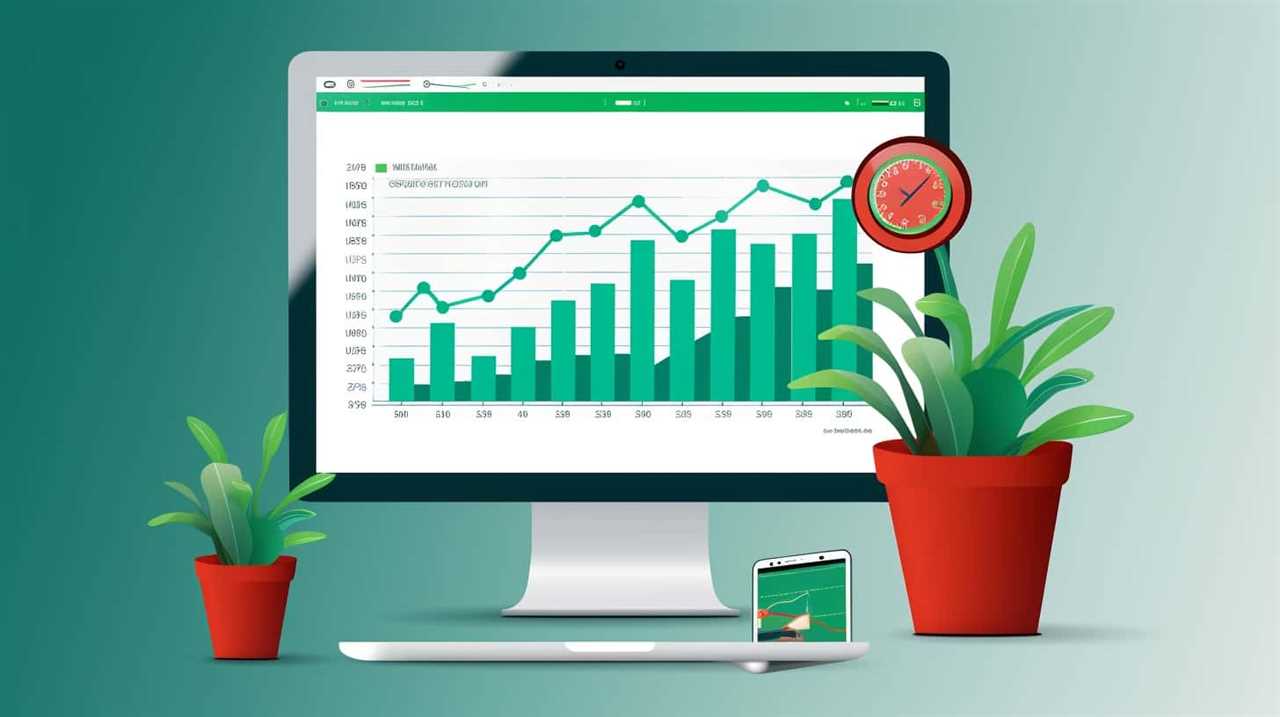Are you prepared to discover the potential of Google Ads for your furniture business? Fear not, we have everything under control.
In this article, we’ll guide you through designing a winning digital strategy that will elevate your business to new heights. From understanding your target audience to crafting compelling ad copy, we’ll show you how to master the art of Google Ads.
Get ready to make your mark in the digital world and watch your furniture store thrive. Let’s dive in!
Key Takeaways
- Google Ads can significantly boost a furniture store’s online visibility and increase customer reach.
- Understanding the target audience is key to designing a successful digital strategy.
- Setting clear campaign goals aligns digital efforts with overall business objectives.
- Optimizing campaign performance through continuous monitoring and adjustments leads to long-term success.
The Power of Google Ads for Furniture Stores
Using Google Ads can significantly boost our furniture store’s online visibility and increase our customer reach. The power of Google Ads lies in its sophisticated targeting strategies, allowing us to reach our desired audience with precision and efficiency. With ad targeting, we can ensure that our ads are displayed to the right people at the right time, maximizing our chances of converting them into loyal customers.

One of the key targeting strategies we can employ is demographic targeting. By understanding the demographics of our target market, such as age, gender, and location, we can tailor our ads to resonate with their specific needs and preferences. For example, if our target audience is young professionals living in urban areas, we can create ads that highlight the modern and sleek designs of our furniture, appealing to their sense of style and functionality.
Another effective targeting strategy is interest-based targeting. By analyzing users’ browsing behavior and interests, Google Ads allows us to display our ads to individuals who’ve shown an interest in home decor, interior design, or related topics. This ensures that our ads are shown to people who are already likely to be interested in our products, increasing the chances of engagement and conversion.
Understanding Your Target Audience
When it comes to designing a successful digital strategy, understanding your target audience is key. By analyzing demographics and psychographics, we can gain valuable insights into who our customers are and what drives their purchasing decisions.
Consumer behavior analysis allows us to dig deeper and understand their motivations, preferences, and needs. Armed with this knowledge, we can create targeted Google Ads campaigns that resonate with our audience and drive conversion.

Demographics and Psychographics
Our digital strategy for Google Ads for Furniture Stores begins with understanding the demographics and psychographics of our target audience. By conducting thorough market research, we can gain insights into consumer preferences and tailor our advertising efforts accordingly.
Here are four key factors to consider when studying the demographics and psychographics of our target audience:
- Age: Understanding the age range of our potential customers allows us to create relevant and appealing ads that resonate with their specific needs and desires.
- Location: Knowing the geographical location of our target audience helps us target ads to specific regions, ensuring that our message reaches those who are most likely to convert.
- Interests and Hobbies: Identifying the interests and hobbies of our target audience enables us to craft ads that align with their passions and capture their attention.
- Lifestyle and Values: Understanding the lifestyle and values of our target audience allows us to create ads that reflect their aspirations and values, establishing a connection and fostering brand loyalty.
Consumer Behavior Analysis
To better understand our target audience, it’s important to analyze consumer behavior. By studying consumer decision-making and online shopping trends, we can gain valuable insights into the preferences and habits of our potential customers. Understanding consumer behavior allows us to tailor our marketing strategies and Google Ads campaigns to effectively reach and engage with our target audience.
Consumer decision-making is influenced by various factors such as personal needs, preferences, and external influences. By analyzing these factors, we can identify the key drivers behind our customers’ purchasing decisions and create compelling ads that resonate with their desires and motivations.

Furthermore, keeping abreast of online shopping trends is crucial in today’s digital landscape. As consumers increasingly turn to the internet to research and purchase furniture, it’s important for furniture stores to align their Google Ads campaigns accordingly. This involves understanding the platforms and channels that our target audience uses, as well as the types of content that they engage with the most.
Setting Clear Campaign Goals
As we move into the topic of setting clear campaign goals for your furniture store’s Google Ads strategy, there are several important points to consider.
First, defining your desired outcomes is crucial in order to align your digital efforts with your overall business objectives.
Second, measuring the success of your campaigns through key performance indicators will provide valuable insights into their effectiveness.

Lastly, optimizing the alignment between your goals and the strategies you employ will ensure that your Google Ads campaigns drive the desired results.
Let’s explore these points further to develop a winning digital strategy for your furniture store.
Defining Desired Outcomes
We will begin by clearly defining our campaign goals to effectively set desired outcomes for our Google Ads strategy for furniture stores. Defining campaign objectives is crucial in order to create a focused and effective advertising campaign.
Here are four key steps to consider when setting clear campaign goals:

- Identify specific objectives: Determine what you want to achieve with your Google Ads campaign, such as increasing website traffic, generating leads, or boosting sales.
- Set measurable targets: Establish quantifiable goals that can be tracked and measured, such as a target number of clicks, conversions, or return on ad spend (ROAS).
- Understand your target audience: Define your ideal customer profile and use this information to create effective ad targeting strategies that will reach and resonate with your target audience.
- Align goals with your overall marketing strategy: Ensure that your campaign goals align with your broader marketing objectives, so that your Google Ads efforts contribute to the overall success of your furniture store.
Measuring Campaign Success
To effectively measure the success of our campaign, it’s important to set clear campaign goals that can be tracked and analyzed.
One key metric to consider is measuring conversion rates, which tells us how many users are taking the desired action on our website, such as making a purchase or filling out a contact form.
By analyzing click-through rates, we can understand how successful our ads are in generating interest and driving traffic to our website.
By setting specific goals for these metrics, we can track our progress and make data-driven decisions to optimize our campaigns.

It’s crucial to regularly monitor these metrics and make adjustments as needed to ensure that our campaign is on track to meet its objectives.
Optimizing Goal Alignment
How can we ensure that our campaign goals are aligned and clear?
Setting clear campaign goals is crucial for the success of any digital marketing strategy. To optimize goal alignment, consider the following:
- Define specific objectives: Clearly articulate what you want to achieve with your campaign. Whether it’s increasing website traffic, generating leads, or boosting sales, setting specific goals will help guide your efforts.
- Align goals with business objectives: Ensure that your campaign goals align with your overall business objectives. This will help you focus on what truly matters and prioritize your efforts accordingly.
- Use SMART criteria: Make your goals SMART (Specific, Measurable, Achievable, Relevant, and Time-bound). This will provide a clear framework for goal setting and make it easier to measure campaign success.
- Regularly measure and evaluate: Continuously monitor and measure your campaign performance to determine if your goals are being met. Make adjustments as needed to optimize your results.
Conducting Effective Keyword Research
When conducting effective keyword research for Google Ads, it’s essential to focus on relevant and high-volume search terms. Understanding the competition analysis and targeting long tail keywords can give your furniture store a competitive edge in the digital landscape.

Firstly, conducting a thorough competition analysis is crucial. By identifying the keywords your competitors are using, you can uncover valuable insights about their strategies. This analysis allows you to identify gaps in the market and discover untapped opportunities that can set you apart from the competition.
Additionally, targeting long tail keywords is a strategic approach that can yield excellent results. Long tail keywords are more specific and have lower search volumes compared to broad keywords. However, they often have higher conversion rates and attract more qualified traffic. By incorporating these long tail keywords into your Google Ads campaigns, you can reach a highly targeted audience that’s more likely to convert into customers.
To conduct effective keyword research, utilize tools like Google Keyword Planner, SEMrush, or Ahrefs. These tools provide valuable data on search volumes, competition levels, and keyword variations. By leveraging these insights, you can optimize your Google Ads campaigns to reach the right audience and drive more qualified traffic to your furniture store’s website.
Crafting Compelling Ad Copy
Crafting compelling ad copy is crucial for the success of your Google Ads campaign. By selecting the right keywords for targeting, you can ensure that your ads appear in front of the right audience when they’re actively searching for furniture.

Additionally, including a strong call to action in your ad copy will encourage potential customers to take the desired action, such as visiting your website or making a purchase.
Keywords for Targeting
We frequently use specific keywords to target our audience and create compelling ad copy for our furniture store. By employing effective targeting strategies and implementing keyword optimization techniques, we ensure that our ads reach the right customers at the right time.
Here are four key considerations when selecting keywords for targeting:
- Relevance: Choose keywords that closely align with the products and services offered by your furniture store. This ensures that your ads are shown to users who are actively searching for what you have to offer.
- Search Volume: Focus on keywords that have a high search volume to maximize the visibility of your ads. This allows you to reach a larger audience and increase the chances of attracting potential customers.
- Long-tail Keywords: Incorporate long-tail keywords into your ad copy to target users who are searching for specific furniture items or styles. These keywords often have lower competition, making it easier for your ads to stand out.
- Negative Keywords: Exclude irrelevant terms by using negative keywords. This helps refine your targeting and prevents your ads from being shown to users who are unlikely to convert.
Call to Action
By utilizing effective call-to-action techniques, we engage our audience and compel them to take action through our ad copy. Crafting compelling ad copy is crucial for driving conversions and maximizing the effectiveness of our Google Ads campaign.

Effective call to action strategies involve understanding the psychology of persuasive call to actions and using that knowledge to create compelling and irresistible ad copy. We need to use strong action verbs, create a sense of urgency, and offer clear and specific instructions to our audience. Additionally, incorporating social proof, such as testimonials or reviews, can enhance the persuasiveness of our call to action.
By carefully crafting our ad copy and implementing these effective strategies, we can increase click-through rates and ultimately drive more conversions.
Now, let’s move on to the next section about designing eye-catching display ads.
Designing Eye-Catching Display Ads
To successfully capture the attention of potential customers, it’s important to carefully design eye-catching display ads that effectively showcase the furniture products offered by your store. Here are four key strategies to consider when designing your display ads:

- Eye-catching graphic design: Incorporate visually appealing elements such as high-resolution images, creative typography, and engaging illustrations. These elements will help your ads stand out and grab the viewer’s attention.
- Effective color schemes: Choose colors that complement your furniture products and create a harmonious visual experience. Consider using contrasting colors to make important information, such as discounts or promotions, pop out and attract attention.
- Clear and concise messaging: Craft compelling headlines and concise copy that clearly communicates the unique selling points of your furniture products. Use language that’s persuasive and entices the viewer to click on your ad for more information.
- Compelling call-to-action: Include a strong call-to-action that encourages viewers to take the desired action, such as visiting your website or making a purchase. Use action-oriented words and phrases to create a sense of urgency and drive conversions.
Utilizing Ad Extensions for Maximum Impact
When incorporating ad extensions into your digital strategy, you can enhance the effectiveness of your display ads by providing additional information and options to potential customers. Ad extensions are a powerful tool that can improve the visibility and performance of your Google Ads. By utilizing ad extension best practices, you can effectively communicate your unique selling points and increase ad visibility with extensions.
One of the most popular ad extensions is the sitelink extension, which allows you to include additional links to specific pages on your website. This gives customers more options to explore and increases the chances of them finding what they’re looking for.
Another useful extension is the call extension, which adds a clickable phone number to your ad, making it easier for customers to contact you directly. Location extensions are also valuable for brick-and-mortar furniture stores, as they display your address and a map to your store location. This is especially useful for customers who prefer to shop in-person.
Optimizing Landing Pages for Conversion
When it comes to optimizing landing pages for conversion, there are a few key points to keep in mind.

First, visual appeal and user experience (UX) are crucial in capturing the attention of potential customers. A well-designed and visually appealing landing page can make a significant impact on whether or not visitors choose to stay and explore further.
Additionally, the placement of your call-to-action (CTA) buttons plays a vital role in guiding users towards taking the desired action, such as making a purchase or filling out a contact form.
Visual Appeal and UX
One key aspect of optimizing landing pages for conversion is ensuring a visually appealing and user-friendly design. When it comes to attracting and retaining customers, visual appeal and user experience (UX) play a crucial role. Here are four essential elements to consider when designing your landing pages:
- Clear and compelling visuals: Use high-quality images that showcase your furniture products in an attractive and enticing way. Visuals should be relevant, engaging, and optimized for fast loading.
- Intuitive navigation: Make it easy for users to find what they’re looking for by organizing your landing page in a logical and intuitive manner. Use clear headings, menus, and clickable buttons to guide users through their journey.
- Responsive design: Ensure that your landing page is fully responsive and optimized for mobile devices. This will provide a seamless user experience across different screen sizes and increase the chances of conversion.
- Call-to-action (CTA) optimization: Place your CTAs strategically throughout the landing page, using contrasting colors and compelling copy to encourage users to take action. Make sure your CTAs are clear, concise, and easily visible.
Call-To-Action Placement
To optimize landing pages for conversion, we focus on strategically placing our call-to-action (CTA) buttons to guide users through their journey and drive them to take action. Designing effective banners and increasing click-through rates are crucial aspects of this process.

When it comes to CTA placement, we need to consider the user’s path on the landing page. We want to make sure the CTA is visible and easily accessible. Placing the CTA above the fold is a common practice, as it ensures that users see it immediately upon landing on the page. Additionally, we can use contrasting colors and compelling copy to draw attention to the CTA button.
Another effective approach is to include multiple CTAs throughout the landing page, strategically placed at key points in the user’s journey. This way, we provide multiple opportunities for users to take action without being too pushy.
Tracking and Analyzing Campaign Performance
We track and analyze the performance of our Google Ads campaigns using a comprehensive set of metrics and tools.
Here are four important aspects of tracking metrics and campaign analysis that we focus on:

- Click-through Rate (CTR): We closely monitor the CTR to understand how effective our ads are in generating interest and driving traffic to our website. A high CTR indicates that our ads are resonating with our target audience.
- Conversion Rate: Tracking the conversion rate helps us measure the effectiveness of our campaigns in terms of generating actual sales or desired actions. By analyzing this metric, we can identify which campaigns or keywords are driving the most conversions.
- Cost per Conversion: This metric allows us to evaluate the efficiency of our advertising spend. By calculating the cost per conversion, we can optimize our campaigns to ensure we’re getting the best return on investment.
- Keyword Performance: We closely monitor the performance of different keywords to understand which ones are driving the most valuable traffic. By analyzing keyword data, we can make informed decisions about which keywords to bid on and optimize our campaigns accordingly.
By tracking these metrics and conducting thorough campaign analysis, we can continuously refine and improve our Google Ads strategy.
Now, let’s move on to discuss budgeting and bidding strategies to further enhance our digital advertising efforts.
Budgeting and Bidding Strategies
To effectively manage our Google Ads campaigns for furniture stores, it’s crucial for us to implement strategic budgeting and bidding strategies.
Budget allocation plays a vital role in determining the success of our advertising efforts. By carefully allocating our budget to different campaigns and ad groups, we can ensure that we’re targeting the right audience and maximizing our return on investment. It’s important to regularly review and adjust our budget allocation based on the performance of our campaigns, focusing more on areas that are generating higher conversions and revenue.

In addition to budget allocation, bid management is another key aspect of our Google Ads strategy. Bidding strategies determine how much we’re willing to pay for each click on our ads. We’ve several options to choose from, including manual bidding, automated bidding, and target CPA bidding.
Manual bidding allows us to have full control over our bids, while automated bidding uses machine learning algorithms to optimize our bids for maximum results. Target CPA bidding, on the other hand, allows us to set a specific cost per acquisition goal, and the system adjusts our bids accordingly.
Testing and Optimizing Ad Variations
In order to enhance the effectiveness of our Google Ads campaigns for furniture stores, we’ll experiment with and fine-tune ad variations. Testing and optimizing ad variations is crucial for improving ad performance and maximizing our return on investment.
Here are four key strategies we’ll implement:

- A/B Testing: We’ll create multiple versions of our ads with different headlines, descriptions, and call-to-actions. By running A/B tests, we can compare the performance of each variation and identify which elements resonate better with our target audience.
- Landing Page Optimization: Alongside ad variations, we’ll also test different landing page designs and content layouts. By analyzing user behavior and conversion rates, we can identify the most effective landing page elements and make data-driven decisions to maximize conversions.
- Ad Extensions: We’ll utilize various ad extensions, such as sitelinks, callouts, and structured snippets, to provide additional information and value to potential customers. By testing different combinations of ad extensions, we can improve ad visibility, click-through rates, and overall ad performance.
- Ad Scheduling: We’ll analyze data to determine the most effective times of day or days of the week to display our ads. By adjusting our ad scheduling based on this information, we can ensure our ads are shown when our target audience is most likely to engage and convert.
Utilizing Remarketing to Reach Potential Customers
By utilizing remarketing techniques, we can effectively reach potential customers for furniture stores through our Google Ads campaigns. Remarketing allows us to target individuals who’ve previously visited our website or interacted with our brand in some way. This powerful strategy helps us stay at the top of their minds and increases the chances of converting them into paying customers.
To improve our remarketing strategies, we need to focus on personalized ad targeting. Instead of showing generic ads to everyone, we can create customized ads based on the specific products or categories that potential customers have shown interest in. By tailoring our messaging and offers to their preferences, we can capture their attention and motivate them to take action.
One way to achieve personalized ad targeting is by segmenting our audience based on their behavior on our website. We can create different remarketing lists for users who’ve browsed specific product pages, added items to their cart but didn’t complete the purchase, or those who’ve made a purchase in the past. This segmentation allows us to show relevant ads that resonate with their previous interactions, increasing the likelihood of conversions.
Furthermore, we can leverage dynamic remarketing to display ads featuring the exact products that potential customers have viewed on our website. This level of personalization enhances the user experience and encourages them to revisit our website and make a purchase.

Leveraging Local Search Ads for Geo-targeting
Our furniture store’s digital strategy includes leveraging local search ads for geo-targeting to reach potential customers in specific areas. Geo-targeting strategies allow us to optimize our local ads and ensure that they’re displayed to the right audience at the right time.
Here are four key ways we’re using local ad optimization to maximize our reach and drive more foot traffic to our furniture store:
- Location-based keywords: We research and incorporate location-specific keywords into our ad campaigns to ensure that our ads appear when potential customers search for furniture in their area. This helps us target customers who are actively looking for furniture near them.
- Geofencing: By setting up virtual boundaries around specific locations, we can target our ads to users within those boundaries. This enables us to reach potential customers who are physically near our store and more likely to visit.
- Local ad extensions: We make use of ad extensions that provide additional information about our store, such as our address, phone number, and store hours. This helps potential customers find us easily and increases the likelihood of them visiting our store.
- Local landing pages: We create dedicated landing pages for each location, optimized with relevant keywords and tailored content. This ensures that potential customers who click on our ads are directed to a page that specifically meets their needs and provides them with the information they’re looking for.
Staying Ahead With Continuous Campaign Monitoring and Optimization
To stay ahead with continuous campaign monitoring and optimization, we regularly analyze our data and make necessary adjustments to ensure maximum effectiveness. By conducting continuous campaign analysis, we are able to identify trends, patterns, and areas for improvement in real time. This allows us to optimize our Google Ads strategy and achieve better results for our furniture store.
In order to provide a visual representation of our monitoring and optimization process, we have created the following table:

| Action | Frequency | Purpose |
|---|---|---|
| Analyze campaign data | Weekly | Identify performance trends and patterns |
| Adjust keywords and bids | Bi-weekly | Optimize targeting and maximize ROI |
| A/B test ad creatives | Monthly | Determine which ads resonate best with our target audience |
By conducting weekly data analysis, we can quickly identify any issues or opportunities that arise. This allows us to make timely adjustments to our keywords, bids, and ad creatives, ensuring that we are constantly optimizing our campaign for maximum effectiveness.
Additionally, our bi-weekly adjustments to keywords and bids help us to continuously refine our targeting and improve our return on investment. By monitoring the performance of different keywords and adjusting our bids accordingly, we can ensure that our ads are reaching the right audience at the right time.
Furthermore, our monthly A/B testing of ad creatives allows us to experiment with different messaging and visuals to determine which ones resonate best with our target audience. This helps us to optimize our ad content and drive better engagement and conversions.
Frequently Asked Questions
How Can Furniture Stores Effectively Use Google Ads to Target Customers in Specific Geographical Locations?
To effectively target customers in specific geographical locations, furniture stores can use Google Ads by implementing targeting strategies and ad scheduling. This allows us to reach our desired audience at the right time and place, maximizing our digital marketing efforts.

What Are Some Strategies for Continuously Monitoring and Optimizing Google Ad Campaigns for Furniture Stores?
To continuously monitor and optimize our Google ad campaigns for furniture stores, we employ strategies like A/B testing and analyzing ad performance. These tactics help us refine our approach and ensure maximum effectiveness in reaching our target customers.
How Can Furniture Stores Leverage Local Search Ads to Reach Potential Customers in Their Area?
When it comes to reaching potential customers in our area, we’ve found that leveraging local search ads is key. By following best practices and studying case studies, we’ve learned how to create compelling ad copy that targets local customers effectively.
What Are Some Budgeting and Bidding Strategies That Furniture Stores Can Implement to Maximize Their Return on Investment With Google Ads?
To maximize our return on investment with Google Ads, we implement budgeting strategies and bidding strategies. By carefully allocating our budget and strategically bidding on keywords, we ensure that our ads reach the right audience and drive valuable traffic to our furniture store.
How Can Furniture Stores Effectively Use Remarketing to Reach Potential Customers Who Have Shown Interest in Their Products or Services?
To effectively reach potential customers who have shown interest in our products or services, we can use custom audiences on Facebook ads. Additionally, collaborating with influencers can help promote our products and increase brand awareness.

Conclusion
In the ever-evolving digital landscape, furniture stores must harness the power of Google Ads to drive success. Understanding our audience and setting clear goals are crucial steps in crafting a compelling digital strategy.
By conducting effective keyword research and crafting captivating ad copy, we can engage potential customers and drive conversions. Utilizing remarketing and local search ads allows us to target specific demographics and locations.
By continuously monitoring and optimizing our campaigns, we can stay ahead and achieve lasting success in the competitive furniture market.
Let’s embrace the digital realm and unlock the potential of Google Ads.











